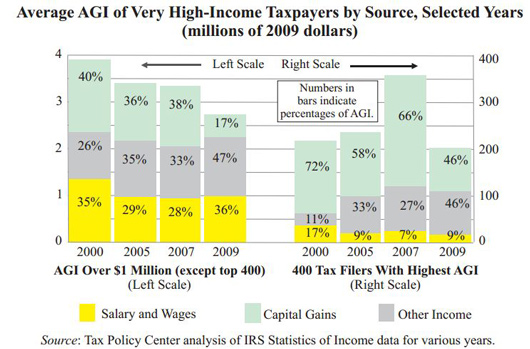Recently, the IRS reported the average tax rate of the top 400 highest earning Americans. With average earnings of $200 million per filer, you might think this group paid a tax rate close to the maximum, but you’d be wrong. In 2009, this elite group enjoyed an average tax rate of just 19.9% – closer to someone earning about $75,000 per year.
The numbers are staggering. Last year billionaire investor Warren Buffet enjoyed a tax rate of just 17.4% while his secretary paid 35.8%. Republican Presidential candidate Mitt Romney paid just 13.9% in taxes on his $21.7 million in income.
America’s tax system is progressive – meaning higher tax rates are paid by those who can afford it – so how are millionaires paying the same tax rate as those in the middle class? In an effort to explain this seemingly unfair tax advantage, the nonpartisan Tax Policy Center took a look at the income and taxes of the very rich. Here’s what they found:
- In 2009, the wealthiest Americans got 47% of their income from capital gains.
- The average millionaire (not in the top 400) claimed just 17% of their income from capital gains.
- Most middle class Americans claim a much smaller proportion (if any) from capital gains.
Capital gains, which is income derived from the sale of stock, property, or other capital assets is only taxed at a rate of 15%. Meanwhile salary and wage income – the primary source of income for most middle class Americans – doesn’t enjoy the same tax advantage as capital gains. So a single filer earning $50,000 in 2009 actually paid a higher tax rate than someone who took home $100 million from capital gains.

In 2009, for the average filer in the top 400, $100 million of their earnings came from capital gains.
It hasn’t always been this way. From 1992-2002, the average tax rate of the top 400 filers was higher – about 25%. Then in 2003, the George W. Bush Administration reduced the capital gains tax rate to 15%. The average tax rates of the top 400 plummeted, and have stayed below 20% ever since.
Capital gains rates are set by the federal government – and it’s difficult to predict their trajectory in the future. But many states also levy their own capital gains tax – Washington is one of just 8 states that does not. Last year, a proposal for a capital gains tax from the Washington State Budget and Policy Center was introduced by the state legislature, but failed to advance.
It’s something that deserves a second look. A state capital gains tax would provide much-needed funding for K-12 education, public health, higher education, and infrastructure improvements. It would also ensure more equity in our backward state tax structure, and ensure high-quality services that are crucial to attracting and keeping good jobs.
More To Read
April 17, 2024
2023-24 Impact and Gratitude Report
Reflecting on a year of progress and transition at EOI
April 12, 2024
Welcoming our New Executive Director, Rian Watt!
EOI is excited to begin its next chapter under new leadership
April 4, 2024
Is There a Valid Argument Against Cost-Free College in Washington?
Cost-free college is a meaningful investment that would change lives. What's stopping Washington from making it happen?
